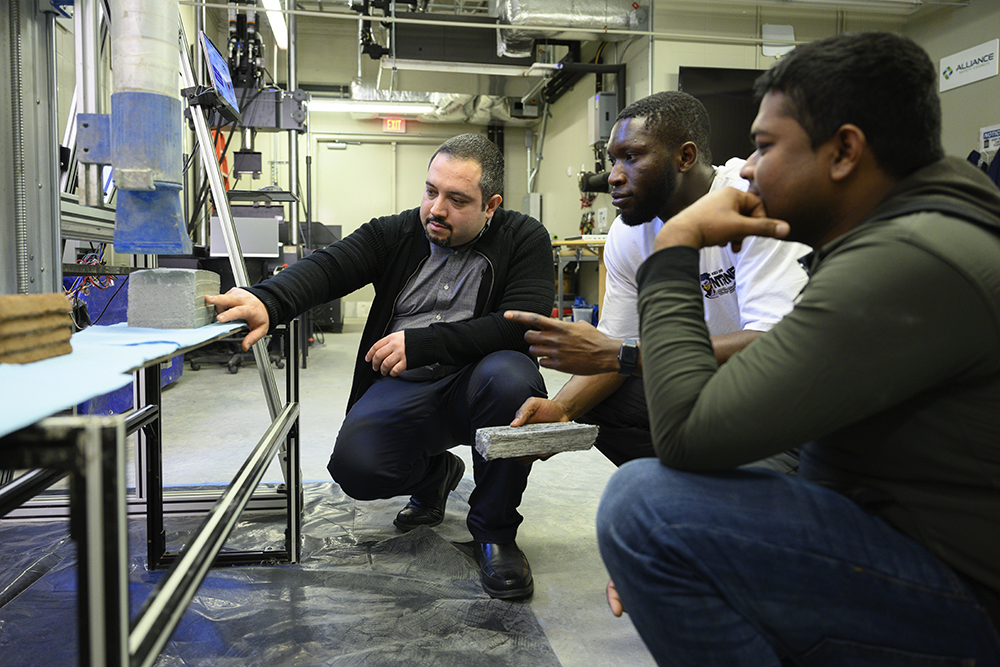LSU Construction Management, NASA Researchers Exploring Use of Lunar Materials for Extraterrestrial Robotic Construction
 December 4, 2023
December 4, 2023
BATON ROUGE, LA – In 2025, NASA’s Artemis 3 will mark humanity’s first return to the Moon since December 1972. The goal of the program is to land two astronauts on the surface of the Moon in order to explore its south pole and begin the process of establishing a long-term presence there.
In order to make this eventual goal a reality, robotic construction technologies will be needed to build a variety of supporting structures, such as habitats, landing pads, and radiation shields. But what to use for construction materials?
LSU Bert S. Turner Construction Management Assistant Professor Ali Kazemian is working with two scientists from NASA Marshall Space Flight Center in Alabama – Michael Fiske, technical fellow, and Jennifer Edmunson, project manager and geologist – to research the use of native raw materials readily available on the surface of the Moon and Mars, namely sulfur and regolith, to develop 3D-printed waterless concrete.
“Molten sulfur is the binder and regolith, i.e., Lunar soil, acts as the filler material,” Kazemian said. “Robotic construction on the Moon using Lunar resources and large-scale 3D-printing technology is the goal. Even shipping raw materials from Earth is cost prohibitive, so the only practical approach is to use the resources which are already available on the Moon and Mars for construction. That is why 3D printing using sulfur-regolith concrete (SRC) is attractive. On the other hand, production of Portland cement concrete, the most commonly used construction material on Earth, will be complicated on the Moon and will require large amounts of water that could otherwise be used for life support or other exploration activities.”
The work, funded by a $200,198 grant from the National Science Foundation, will be carried out at LSU and the NASA Marshall Space Flight Center. Studying the extrusion parameters and the interplay between material-process-environment factors during high-temperature SRC extrusion will mainly take place at LSU. Testing the space resilience of 3D-printed SRC specimens will be carried out jointly at the NASA Marshall Space Flight Center under vacuum conditions and temperature swings, extreme thermal load resistance, and simulated micrometeorite impact resistance.
“The planned research tasks will provide a fundamental understanding of the impacts of high-temperature, extrusion process parameters and environmental factors, such as near-vacuum conditions, on the performance of 3D-printed SRC structures,” Kazemian said. “After reaching these objectives, together with our NASA colleagues, we will work on design and development of a large-scale SRC 3D-printing system at NASA Marshall to validate our research findings on a large scale. For example, by 3D printing a Lunar habitat analog.
“We are currently working on several other projects as well, which are focused on using construction 3D printing to build houses and shelters cheaper and faster, to alleviate the global housing shortage crisis and for disaster relief applications. As such, during this NSF project, we will also look into the potential applications of 3D-printed sulfur concrete on Earth. Sulfur concrete has unique properties, such as superior mechanical strength, rapid hardening, and resilience in acidic and saline environments. Moreover, the fact that sulfur concrete production does not require water is becoming increasingly important particularly as more regions and countries around the world struggle to cope with droughts and water scarcity.”
Like us on Facebook (@lsuengineering) or follow us on Twitter and Instagram (@lsuengineering).
###
Contact: Joshua Duplechain
Director of Communications
225-578-5706
josh@lsu.edu